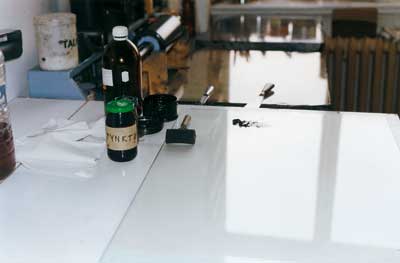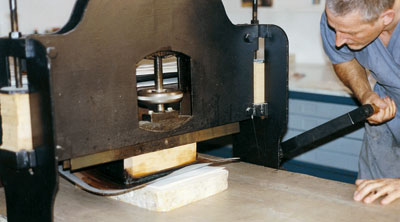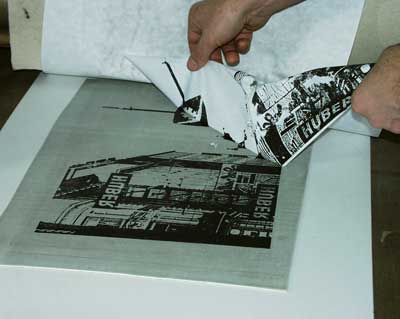
 |
|
 |
 |
 |
|
|||
| HOME | POLSKI |
|
||||
| BIOGRAFIA |
|
|||||
| ENGLISH |
|
|||||
| LITOGRAFIA | LINKI |
|
||||
 |
• O Litografii • Lithography anastatic reprint • Kolor w grafice - wprowadzenie • Kolor w grafice • ¦wiat barw • Litografia czarno-bia³a |
 |
|
|||
| OBIEKTY |
|
|||||
| DYDAKTYKA |
|
|||||
| STUDIO WW |
|
|||||
| KONTAKT |
|
|||||
|
Lithography anastatic reprint 
Lithographic stone or metal plate, after sensitization of the surface, grows very
sensitive to greasiness with even little stains of the substance, which, after appropriate
preparation, can become part of the drawing. To stain stone surface with grease, we do not
have to draw directly on its surface. We can make the drawing on some other kind of ground
and transfer it onto the stone surface. This method offers considerable facilitation, especially
if the drawing is to be made outside the studio. The basic principle of classical reprint is quite
simple and relies on drawing on a sheet of special paper, which is then transferred, by
pressing, on the ground of the matrix proper. 
Paper is moistened with a weak dilution of nitric acid and gum Arabic (for 100 ml of the dilution we add 3 - 4 drops of the acid), (photo 2 .  ). After removal of excess of the preparation, we can start fixing ink with small roller made of sponge. Xerox copies are made on smooth papers, but, after moistening they delaminate easily, just like any other paper. The roller, which turns smoothly, does not damage the toner. We remove the excess of toning solvent and the ink on the roller, when we make first fixtures on an additional Xerox copy. The tone achieved at the beginning weakens with time, and the area outside the drawing grows clear (photo 3).  Dirt should be removed by washing the copy with preparation. Fixing should be made carefully, without excessive moistening of paper and with little ink taken on the roller, water acts repellently on the ink, whereas excess of ink on the print, while pressing, will be squashed, thus giving a non-sharp and enlarged drawing. Paper, which is too wet with preparation, placed on the stone, etches its surface. Reprinted drawing is further subject to retouching, therefore its surface should be fully receptive to further greasing. In order to achieve this, the print with ink should be placed its clean side on filtration blotting - paper and drain off the excess of preparation (photo 4).  ). Also, while pressing, the Xerox copy should be covered with dry filtration blotting - paper. Stone or plate surface, on which the reprint will be made, should be smooth, sensitized or, at least, heated with hot air , (photo 5).  ). The reprint should be made shortly after fixing ink, because paper and ink dry quickly on the toner. Anastatic reprint from Xerox copy can be made on lithographic or relief printing press (l use both of them). Pressing or rolling goes only in one direction with pressure growing gradually stronger (photo 6).  ). While reprinting, only the layer of reprinting ink is impressed on the stone; the Xerox copy is not really damaged and can be used for evaluating the drawing or the next reprint (photo 7). 
One should consider the fact that, while moistening,
paper gets delaminated, which results in the drawing becoming lighter. If the Xerox copy
paper, after reprinting, is not easily taken off as a whole from the stone surface, we should
wait until the next day with this procedure. Staining stone with grease achieved with the
method of anastatic reprint from Xerox copy should be treated as a drawing with lithographic
ink. When ink dries, we can start retouching and then we put talc and gum on the stone
surface. Where reprint is to be linked with other techniques, stone surface should be prepared
for the appropriate drawing technique. Reprint from Xerox copy, due to its perfection, has got
some characteristic features of photography reproduced with the use of Xerox machine, so it
is good to enrich it with supplementary drawing techniques. Using the reprint method we can
also make a composition in big size without the necessity of having the enlarged drawing on
one sheet of paper. For reprint we use smaller fragments of Xerox copies, which, after
preparation and fixing ink on them, are placed in marked places on the stone surface or any
other ground. Using the possibility of fixing greasy ink on the prepared Xerox copy, we can
transfer the drawing on other grounds, ex. paper (photo 8),

linoleum (photo 9), wooden panel
or metal plate.
 The essential feature of this method is the automatic reversal of the drawing, so important for making the matrix in graphic art techniques. While printing, paper is placed directly on the matrix, so that we can obtain the picture reversed again, to the right side. Reprints made from Xerox copies (ordinary and laser) are different and offer, as a result, much greater possibilities, one should master and, if necessary, use while preparing matrices. General access to copying machines and the use of their technical possibilities as well as easy preparation of Xerox copies combined with the possibility of its evaluation before the actual reprinting process are the factors, which should encourage interesting experiments, also in other visual arts activities. Witold Warzywoda |
|
|||||
do gory powrót |
|
design & webmastering Daniel Zagórski |